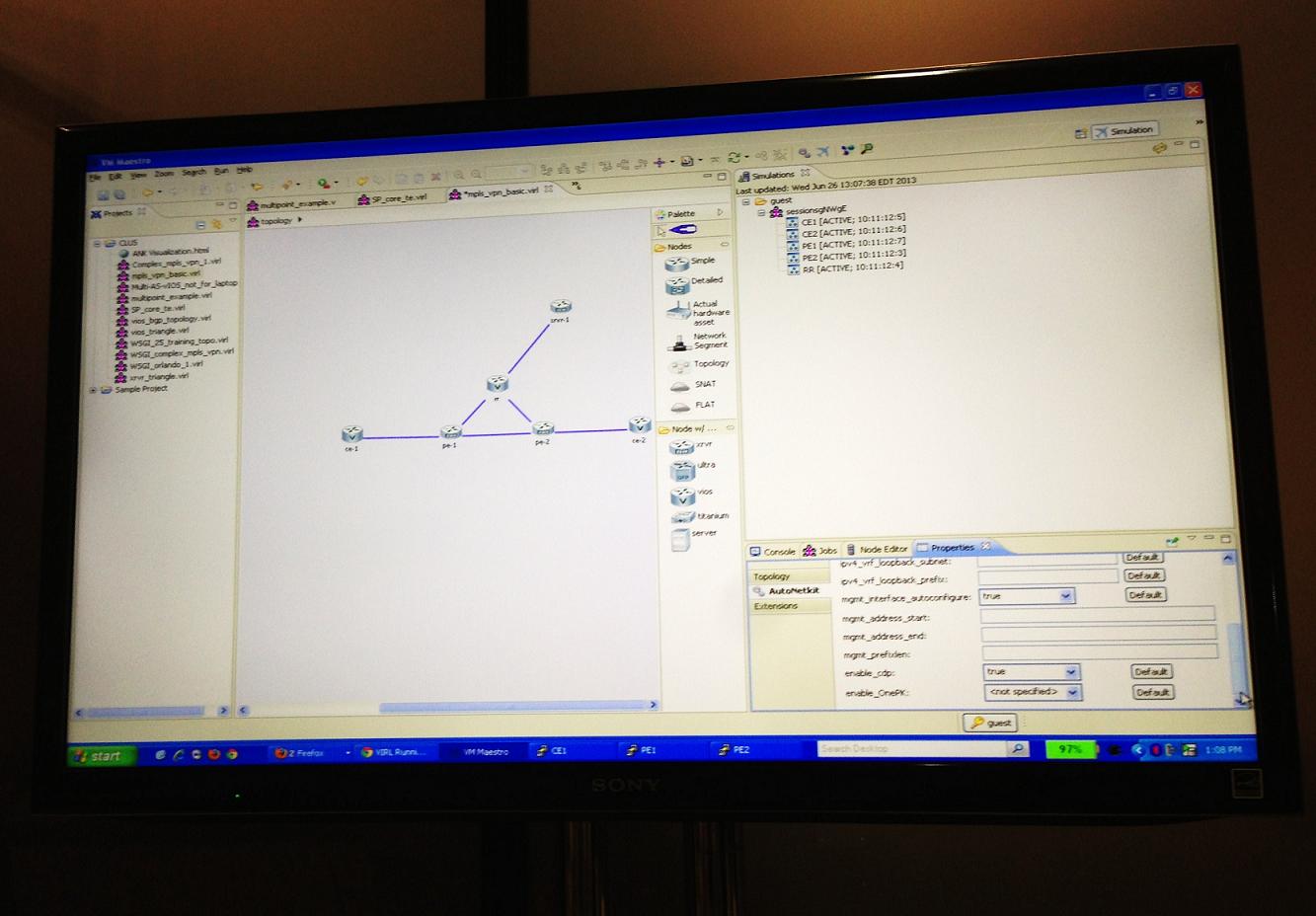At Cisco Live in Orlando I had the chance to demo the Virtual Internet Routing Lab (VIRL). It is Cisco’s answer to GNS3 or Junipers’ Junosphere using virtualization to create virtual network topologies. This tools will be as revolutionary as GNS3, but at a much larger scale. It is an awesome tool that can be used for certification studying but also to validate production designs. Everyone I spoke to couldn’t wait to get their hands on it, including me!
Below is a screen shot of VIRL. It is using Oracles VMMaestro GUI based on Java. In the screen you can see network topology which is drop and drag. On the left side in purple there is a list of all saved networks. The right middle side has a list of supported devices. Top right side has all of the currently running devices and bottom right preconfiguration tabs. To access CLI of these routers, you has to run in simulation mode then Telnet to individual devices. The preconfiguration is a nice feature that allows you preconfigure IP addresses, Loopback interfaces or routing protocols like OSPF or BGP.

Virtual Internet Routing Laboratory screen shot.
VIRL supports virtualizing Cisco’s modified operations system. Cisco created modified versions of their OSes with all features that are not hardware dependent. They are not able to map physical features of all platforms into one tool. It is different than GNS3. VIRL does not use regular IOS version. These virtual routers are basically virtual machines running in the background.
There are four different operating systems that are supported: VIOS (emulates IOS), Titanium (emulates Nexus), XRVR(emulates IOS-XR) and Ultra. These images will be available from Cisco to download. Currently only Ethernet interfaces are supported, but before the public release more interfaces types should be available.
Additionally, you will be able to run virtual servers within the topology. Running any virtual server opens up the testing environment to many capabilities that run in the production networks. There is a feature to SNAT the topology with existing physical networks. Both of these capabilities provide options to scale outside of the virtual environment. The virtualization is so good that Cisco is concerned that people will use these in production.
Cisco is looking at three deployment options:
- Laptop version
- Appliance
- Hosted Access
The first option is running VIRL on your laptop. This is similar to running GNS3. The limitation of this is your laptop’s hardware resources like RAM and CPU. Each VIOS shouldn’t take more than 200-300 MB of RAM. It is the VRVR (IOS-XR) that needs 4GB of RAM (not sure about the other ones).
The second option is connecting to a server internally on your network. Most likely that will be an appliance either virtual or physical. This option works better for large scale topologies with lots of emulated devices. Devices could be accessed with Putty and topology can be designed with the fat client using VMMaestro. The second options fits for validating production network designs.
If you are not interested in locally hosted VIRL, there is a third option which is hosted in Cisco’s cloud. From my conversation with Cisco, this will be accessed using Cisco’s learning network. Access could be provided with VMMaestro or a web design tool. This option is the most scalable and might look similar to Junosphear. Access could be purchased in a similar way as rack rentals but at any time without time slot limitations.
It doesn’t look like Cisco has figured out the pricing and licensing model just yet. All I know is the the laptop version is meant to be affordable anywhere between $100-$500. I would figure the appliance would be little more costly and the cloud hosting much more affordable. “Cisco is not trying to make money on VIRL” (that’s not my quote). They realize that certification and training is just another form of marketing for their productions.
When will it be released to the general public and how can you get your hands on it? Cisco is planning on releasing the first public release in Jan 2014. I asked about beta testing and … well I think they already have way too many people interested. Unless your account team has a lot of pull, January is just right around the corner.
Overall I really liked VIRL. I think there are few bugs for them to iron out. Usability was OK, with a small learning curve. VIRL is going to bring access to platforms that are very difficult to access like IOS-XR and Nexus to every network engineer. The more engineers know how to use these platforms the more they will recommend them. I think it is a win-win for Cisco and for anyone learning about networking.
![]() . دیگر برای پیاده سازی سناریوهای مبتنی بر تکنولوژی Nexus و مباحث Data Center هیچ مشکلی نخواهید داشت
. دیگر برای پیاده سازی سناریوهای مبتنی بر تکنولوژی Nexus و مباحث Data Center هیچ مشکلی نخواهید داشت ![]() . برای اولین بار در ایران ساخت این فایل ارزشمند با ورژن 6 ارایه شده و آموزش ویدئویی استفاده از آن تقدیمتان می گردد . نکاتی در مورد این ارایه بایسته است که باید به عرض شما برسد تا ارزش علمی این ارایه مشخض گردد :
. برای اولین بار در ایران ساخت این فایل ارزشمند با ورژن 6 ارایه شده و آموزش ویدئویی استفاده از آن تقدیمتان می گردد . نکاتی در مورد این ارایه بایسته است که باید به عرض شما برسد تا ارزش علمی این ارایه مشخض گردد :![]() لازم برای استفاده در GNS3 بود .
لازم برای استفاده در GNS3 بود . ![]()
![]() .
. ![]()
![]()


